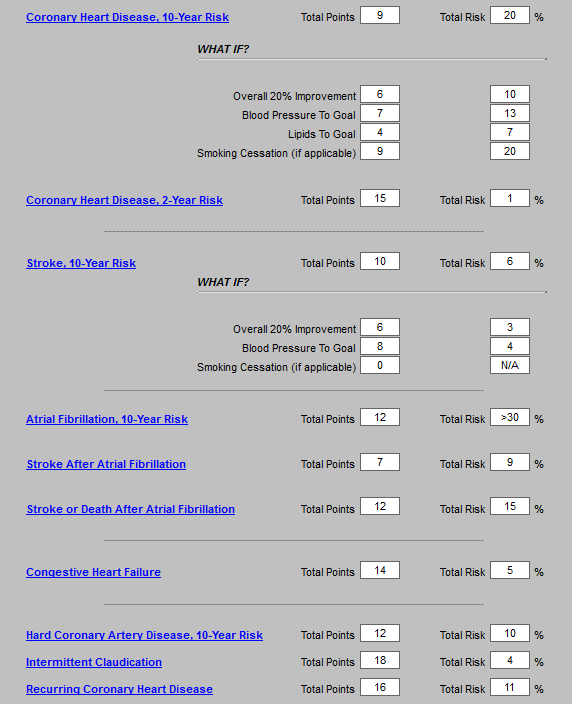

Calculation: 10-year CVD risk X 2 c NO.Their findings were presented Monday at the American College of Cardiology meeting in San Diego.for the Framingham score are therefore approximately 3 times those for SCORE. Table 3 sets out the recommended appropriate intervention strategies according to the percentage risk calculated from the Framingham risk score and the LDL-C value obtained. Treatment targets Although we recommend the use of the Framingham risk chartsHINT: Use the LOS Calculator Attestation SmartLink (. 2017 Use Smartlinks to quickly calculate risk prediction models like ASCVD, Framingham score or.African Americans, especially men, tend to have a higher prevalence of cardiovascular disease, but this differences are not reflected in the Framingham Risk score. Arterial stiffness is a sign of heart disease risk that tends to appear more prominently among African Americans than whites. According to the CDC, 1 out of every 4 deaths in the United States is due to heart disease, making it the leading cause of death for both men and women.
1 Patients are considered to be at "elevated" risk if the Pooled Cohort Equations predicted risk is ≥ 7.5%. This peer-reviewed online calculator uses the Pooled Cohort Equations to estimate the 10-year primary risk of ASCVD (atherosclerotic cardiovascular disease) among patients without pre-existing cardiovascular disease who are between 40 and 79 years of age. The ACC/AHA risk estimator is based on data from multiple community-based populations and was designed to be more applicable to African-Americans.To calculate both risk scores, it is necessary to know a patient's age and sex, smoking history, whether diabetes is present, total and HDL cholesterol, and blood pressure.
Impact of Race on the Pooled Cohort EquationsThe Pooled Cohort Equations were developed and validated among Caucasian and African American men and women who did not have clinical ASCVD. The purpose of the Pooled Cohort Equations is to estimate the risk of ASCVD within a 10-year period among patients who have never had one of these events in the past. Individuals without clinical ASCVD or diabetes who are 40 to 75 years of age with LDL 70 to 189 mg/dL and a 10-year ASCVD risk of 7.5% or higherAs shown above, among patients who do not otherwise have a compelling indication for statin therapy, the Pooled Cohort Equations can be used to estimate primary cardiovascular risk and potential benefit from statin therapy.Want to nerd out? Check out our interactive ASCVD visualization graphing toolASCVD stands for atherosclerotic cardiovascular disease, defined as a nonfatal myocardial infarction (heart attack), coronary heart disease death, or stroke. Individuals 40 to 75 years of age with diabetes and an LDL 70 to 189 mg/dL without clinical ASCVD Individuals with primary elevations of LDL ≥ 190 mg/dL 3Current guidelines for the treatment of cholesterol to reduce cardiovascular risk recommend that the following four groups of patients will benefit from moderate- or high-intensity statin therapy: 2
...


 0 kommentar(er)
0 kommentar(er)
